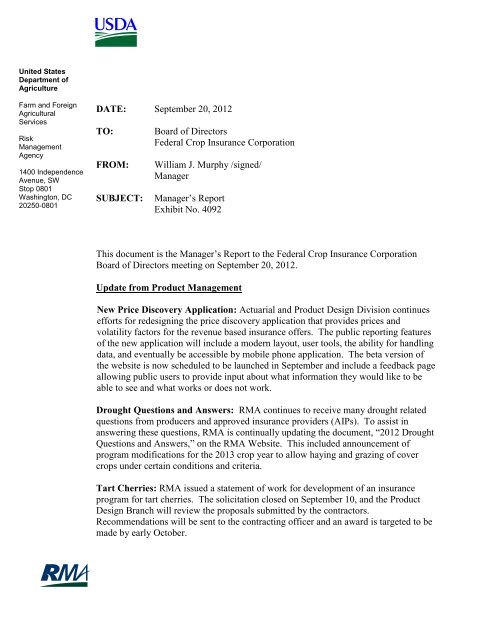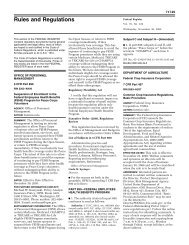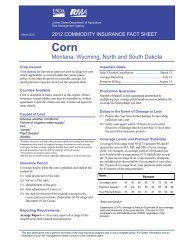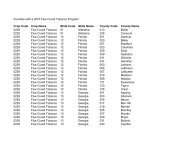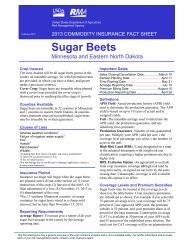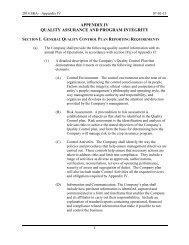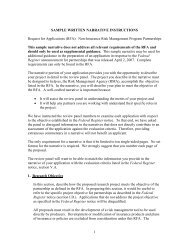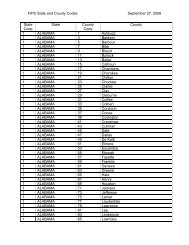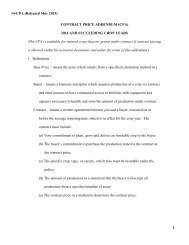RMA-Headquarters Office Letterhead - Risk Management Agency
RMA-Headquarters Office Letterhead - Risk Management Agency
RMA-Headquarters Office Letterhead - Risk Management Agency
- No tags were found...
Create successful ePaper yourself
Turn your PDF publications into a flip-book with our unique Google optimized e-Paper software.
United StatesDepartment ofAgricultureFarm and ForeignAgriculturalServices<strong>Risk</strong><strong>Management</strong><strong>Agency</strong>1400 IndependenceAvenue, SWStop 0801Washington, DC20250-0801DATE: September 20, 2012TO:FROM:SUBJECT:Board of DirectorsFederal Crop Insurance CorporationWilliam J. Murphy /signed/ManagerManager’s ReportExhibit No. 4092This document is the Manager’s Report to the Federal Crop Insurance CorporationBoard of Directors meeting on September 20, 2012.Update from Product <strong>Management</strong>New Price Discovery Application: Actuarial and Product Design Division continuesefforts for redesigning the price discovery application that provides prices andvolatility factors for the revenue based insurance offers. The public reporting featuresof the new application will include a modern layout, user tools, the ability for handlingdata, and eventually be accessible by mobile phone application. The beta version ofthe website is now scheduled to be launched in September and include a feedback pageallowing public users to provide input about what information they would like to beable to see and what works or does not work.Drought Questions and Answers: <strong>RMA</strong> continues to receive many drought relatedquestions from producers and approved insurance providers (AIPs). To assist inanswering these questions, <strong>RMA</strong> is continually updating the document, “2012 DroughtQuestions and Answers,” on the <strong>RMA</strong> Website. This included announcement ofprogram modifications for the 2013 crop year to allow haying and grazing of covercrops under certain conditions and criteria.Tart Cherries: <strong>RMA</strong> issued a statement of work for development of an insuranceprogram for tart cherries. The solicitation closed on September 10, and the ProductDesign Branch will review the proposals submitted by the contractors.Recommendations will be sent to the contracting officer and an award is targeted to bemade by early October.
IT Modernization (ITM) - Accounting Phase: <strong>RMA</strong> has been having AccountingDiscovery meetings with SAIC under the new Agile Scrum methodology fordeveloping business support systems. The “IT Modernization (ITM) AccountingInitiative” will provide <strong>RMA</strong> stakeholders timely and accurate financial reports anddata to support the “Standard Reinsurance Agreement” as part of the Federal CropInsurance program and its external reporting requirements. This initiative will providean opportunity for technology refresh, automation and modernization of businessprocesses bringing standardization and consistency across all of <strong>RMA</strong>’s businesssystems.Hurricane Isaac Impact Analysis Using the Comprehensive Information<strong>Management</strong> System (CIMS): Product <strong>Management</strong> provided maps and support dataregarding the potential impact of Tropical Storm (and Hurricane) Isaac using the CIMS<strong>Management</strong> Decision Report web application. These analytical tools providedsnapshot views of insured acres and liability, as well as planted acres the Farm Service<strong>Agency</strong> (FSA) reports, through the storm’s progression. Maps and reports were alsoprovided based on the National Hurricane Center’s “50 Knot Wind Speed Probabilities”map.New ITM <strong>RMA</strong> Informational Reports System: The Product Analysis andAccounting Division is designing a set of interactive reports for research and analysis of<strong>RMA</strong>'s data. This is the first ITM corporate reporting tool under <strong>RMA</strong>’s ongoing ITMproject. When the initiative is fully completed, this system will allow users to researchactuarial, accounting, and crop policy information using selection criteria to drill downto useful subsets of data. The initial release of this tool to the public is expected forSeptember and has been released internally to <strong>RMA</strong> for selected information andtesting. The initial public release will contain reports for both prices and countycommodity programs, information areas for which <strong>RMA</strong> receives numerous publicrequests. Soon, a number of other informational reports will be created to furtherefficiencies and increase customer service while keeping a consistent look and feelacross <strong>RMA</strong>’s systems.Regulations:Peaches – The Final Rule was published in the Federal Register on August 30. Therevised rule ensures that peaches for processing are not insured as fresh peachproduction resulting in unintended indemnity payments and negatively impactingpremium rates, and simplifies the quality loss adjustment claim processing.Florida Citrus – The comment period ended August 15, and <strong>RMA</strong> is addressing thecomments received. The proposed rule revises the settlement of claims section of thepolicy and updates terms to be consistent with the “Acreage Crop ReportingStreamlining Initiative” (ACRSI) project. The final rule will be published no later thanthe January 31, 2013, contract change date in order to be effective for the 2014 cropyear.
Livestock Gross Margin for Dairy Cattle (LGM-Dairy) – LGM-Dairy sales werediscontinued after the November, 2011 sales period when approximately $13.1 millionwas expended. The Federal Crop Insurance Act limits support to pilot livestockinsurance programs to $20 million in any fiscal year and sales of LGM-Dairy werediscontinued to allow adequate funding for the seven other plans that insurelivestock. <strong>RMA</strong> made available approximately $2.5 million in remaining underwritingcapacity for LGM-Dairy to allow for the August 31, sales period. The $2.5 million wasquickly exhausted.Drought ConditionsOn August 23, the St. Paul RO participated in the Wisconsin State Emergency Board(SEB) meeting to respond to drought disaster designations and review the changes tothe Disaster Declaration Process. The St. Paul RO Drought and Aflatoxin Fact Sheets,MGR-12-007 Deferral of Interest Charges, MGR-12-012 Haying and Grazing of aCover Crop and a brief overview of the crop insurance claim process were covered.Iowa Secretary of Agriculture, William Northey, contacted the St. Paul RO on August6, inquiring about any new or updated provisions regarding aflatoxin in corn sincedrought conditions in Iowa are prompting producer inquiries to their department.Secretary Northey also inquired about any restrictions on double cropping or covercrops that may affect Iowa producers planting forage or small grain after failed corn.The department is investigating emergency feed assistance for drought-affectedlivestock producers. The St. Paul RO has updated its aflatoxin fact sheet and continuesto respond to questions.The St. Paul RO received two phone calls in late August from Iowa producers asking ifaflatoxin has been confirmed. The RO referred the callers to the <strong>RMA</strong> Aflatoxin Factsheet, as well as Iowa State University, who has stated conditions in 2012 were right foraflatoxin. Iowa State is encouraging producers to scout for the visible, green, powderymold aspergillis, which produces aflatoxin. Producers are encouraged to screen and testtheir corn crop when aflatoxin is suspected. The Iowa Department of Agriculture andLand Stewardship required aflatoxin screening and testing of milk received in Iowabeginning August 31, and continuing indefinitely.Large ClaimsTo date, the St. Paul RO has received 472 notifications for large claim reviews (over$500,000), due to the drought and revenue prices.The office of Iowa Congressman Steve King (R-5 th IA) contacted the St. Paul RO onbehalf of several constituents who are concerned about the <strong>RMA</strong> requirement to reviewclaims over
On August 8, the Billings RO Director met with the National Crop Insurance ServicesSouth Dakota State Committee to discuss crop insurance issues. Discussion centered oncurrent prevented planting procedures and <strong>RMA</strong>’s recent Insurance ServicesMemorandums IS-12-003 and IS-12-004. The AIPs are making efforts to inform agentsand producers that the producer has to prove that a cause of loss occurred within theinsurance period; that the acreage has been planted and harvested in at least 1 of the last4 years; and that the acreage is normally available for planting in the spring to beeligible for prevented planting coverage. The AIPs also have a concern with themandatory $200,000 claim actual production history reviews, citing that highcommodity prices will have a huge impact on the number of claims that will go over thelimit and tax their resources so payment of claims will be held up.On August 24, a Billings RO Senior <strong>Risk</strong> <strong>Management</strong> Specialist received an inquiryfrom Al Gustin with KFYR radio in Bismarck, North Dakota concerning the recentlyissued Bulletin No. MGR-12-012: “Emergency Drought Relief – Allowing the Hayingand Grazing of a Cover Crop for the 2013 Crop Year.” The Specialist providedexcerpts directly from the bulletin to be used in the broadcaster’s program. TheSpecialist also provided a copy of the recently released drought relief press releasedeveloped by the Billings RO.October 22 is the trial date for three farmers, a fresh pack potato operation and an agentfrom eastern Washington previously indicted by a federal grand jury. The group isaccused of defrauding the Federal Crop Insurance Corp. of more than $9.5 million incrop insurance payments. According to court documents, the farmers grew a potatovariety not typically suited for processing -- and entered into contracts to sell thepotatoes for processing. When the potatoes failed to meet those requirements, thecontract allegedly required the growers to sell the potatoes for a fraction of their freshpackmarket value. The indictment alleges the contracts were designed to manufacturefalse revenue losses for the growers, who then submitted insurance claims seeking torecoup the losses from selling at bargain prices. The Spokane RO continues to assistthe US Attorney’s <strong>Office</strong> in preparing for trial.Planting DatesOn August 27, the Billings RO Director, Deputy Director, and three <strong>Risk</strong> <strong>Management</strong>Specialists met with Barry Coleman, Executive Director of the Northern CanolaGrowers Association. Topics discussed included production capability of high-oleiccanola varieties, APH recertification procedure, and final planting dates. Barryexpressed appreciation for <strong>RMA</strong>’s willingness to work with the canola industry toaddress final planting dates and their continued interest in the trend yield adjustmentconcept.The Spokane RO has reviewed and made recommendations to implement initial plantingdates for spring types of wheat, barley, canola, oats and dry peas throughout the entireregion. The initial planting dates were implemented to reduce the possibility of replantpayments being made in a year with an open winter.
Crop ExpansionOn August 30, a Billings RO <strong>Risk</strong> <strong>Management</strong> Specialist met with a representative ofMinn-Dak Growers to discuss the agronomics of buckwheat. Buckwheat is primarilyused for making Japanese Soba noodles and is being considered for use in gluten freesnacks. The Specialist viewed fields of buckwheat and discussed Minn-Dak’s requestto expand coverage into Mercer County, North Dakota.Program ImprovementsThe Spokane RO implemented several changes to improve the effectiveness of the cropinsurance programs in the region. The implementations for perennial and spring cropsincluded:- Adding a new type of wine grapes to the central Washington wine producing area.- Working with Product <strong>Management</strong> to implement a new pricing methodology forgrapes.- Separating the blueberry established price between the early-to-late (group B) and thevery late (group A). Prices are significantly higher for the very late varieties.- Adding two new final planting date maps.- Expanding blueberry insurance to several additional counties in Washington due tovastly increased acreage being planted and processing plants being built in thearea. Expansion counties include Benton, Cowlitz, Franklin, Grant, Snohomish, WallaWalla, and Yakima- Expanding “Actual Revenue History Cherry” coverage into three additional countiesincluding Sherman & Gilliam counties in Oregon and Kittitas County, WashingtonThe Davis RO has incorporated a new appraisal method to the “Blueberry LossAdjustment Standards Handbook” to address hand harvest appraisal situations where noproduction has yet been harvested (from highbush or rabbiteye varieties), and thebushes have a heavy fruit load. The current procedure was designed for situationswhere some production would already have been harvested prior to appraisal. Thesuggested changes reduce the number of bushes per sample from four consecutivebushes per sample to one bush per sample.Crop YieldsOn August 20, two St. Paul RO <strong>Risk</strong> <strong>Management</strong> Specialists met with representativesfrom Organic Valley in La Farge, Wisconsin to discuss program issues involving cropinsurance for organic producers and the impact drought has had on organic crops andlivestock. Also included was a tour of Turkey Ridge Organic Apple Farm in Gays Mills,Wisconsin. These apple producers use product diversification as their main strategy inrisk mitigation. Both Organic Valley and Turkey Ridge expressed how much theyappreciated the St. Paul RO’s initiative and kind gesture; however, they also voicedtheir frustration with <strong>RMA</strong>’s organic rating methodology and requested organicproducers pay the same rates for crop insurance as conventional producers. On August
21, the specialists attended the 21 st Annual Midwestern BioAg Field Day. The coursesoffered addressed issues such as soil health and correction, building yields, and theimportance of quality forages for livestock.A Senior <strong>Risk</strong> <strong>Management</strong> Specialist and the <strong>Risk</strong> <strong>Management</strong> Analyst from theBillings RO met with two representatives from the Montana Department of Revenue(Property Assessment Division) to discuss potential uses of crop insurance yield data tocontest agricultural assessment/property tax valuations. Currently, the MontanaDepartment of Revenue uses USDA’s Natural Resources Conservation Servicepublished crop yield estimates by soil type to determine the assessed valuation ofagricultural land. APH and transitional yield concepts were explained to the tworepresentatives from the Montana Department of Revenue, so they have a betterunderstanding of the crop insurance yield metrics that continue to be presented to theMontana Department of Revenue in the context of their property tax appeals process.Fall Update MeetingOn August 9, the Billings RO Director and a <strong>Risk</strong> <strong>Management</strong> Specialist hosted a fallcrop insurance update meeting for agents in Pierre, South Dakota. Approximately 55people attended the meeting. Topics presented included the <strong>RMA</strong> regional and nationalchanges for 2013, prevented planting issues and concerns for the 2012 loss season, 2013crop year actuarial changes, and changes to the “2013 Written Agreement Handbook.”ComplianceFinal Findings Issued Since the August 2012 Board MeetingSince the August Board meeting, Compliance has issued final findings to reinsuredcompanies for the following amounts: premium overstatements - $140,420; indemnityoverpayments - $10,179,038; premium understatements - $9,244; and indemnityunderpayments - $12,803. In addition, Compliance reported a $1,570,880 settlementfrom the 2005 crop year.National Program Operations Review (NPOR)The selected companies for 2011 crop year are:CRCO-ERCO-MRCO-NRCO-SRCO-WRCO-Occidental Fire and Casualty (Agrilogic - OX)XL Reinsurance (Heartland - GI)Country Mutual (CM)Prevented PlantingRural Community Insurance Services (EF)American Agricultural Insurance Company (FA)
Supplemental Revenue Assistance Program (SURE) ReferralsAs of September 4, the Regional Compliance <strong>Office</strong>s have received 7,046 SUREreferrals from FSA or about 30 more than was reported to the Board in the Augustreport. Since FSA relies on crop insurance program data to calculate payments underSURE, FSA is in a position to discover reporting discrepancies while reviewingproducer applications. Compliance is currently receiving referrals for the 2008, 2009,and 2010 crop year from FSA.


